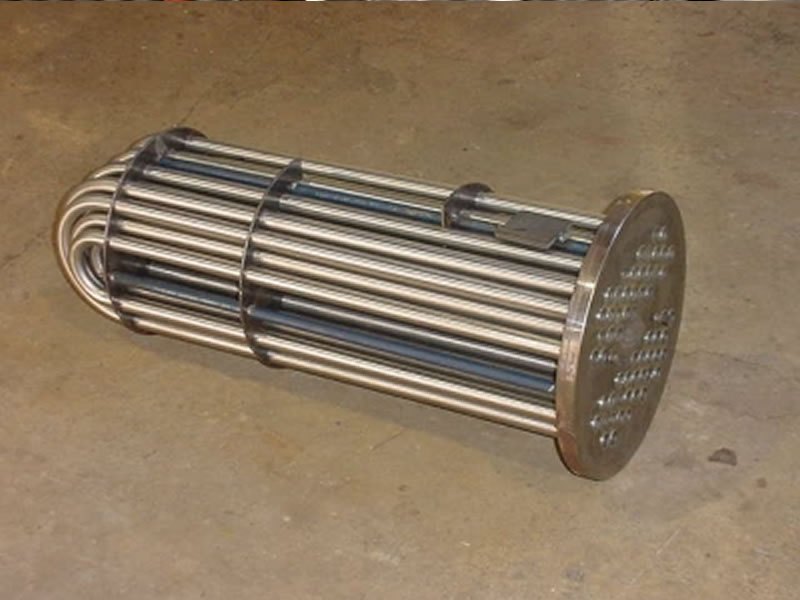Introduction
Tube bundle condenser is a specialized type of shell and tube heat exchanger designed to condense vapors into liquid by efficiently transferring heat to a cooling medium such as water or air. It plays a crucial role in various industrial applications, including power plants, chemical processing, oil refineries, HVAC systems, and pharmaceutical industries, where efficient heat dissipation and vapor condensation are essential for operational efficiency. The tube bundle within the condenser is made up of multiple tubes arranged inside a shell, allowing effective heat transfer between the vapor and the cooling medium. The vapor loses heat upon contact with the tube surfaces, leading to condensation. These condensers are known for their robust construction, high heat transfer efficiency, and ability to withstand extreme pressures and temperatures.
Key Features of a Tube Bundle Condenser
Tube Bundle Construction
- A tube bundle consists of multiple tubes enclosed within a shell, forming the core heat exchange surface.
- The tubes are supported by baffles, which maintain their positioning and enhance fluid distribution.
- Tie rods are used to hold the bundle in place and prevent mechanical vibrations.
- The shell houses the tube bundle, allowing the cooling medium (water or air) to flow over or inside the tubes.
- The material selection for tubes is critical for efficient heat transfer, with options including stainless steel, copper, cupronickel, and titanium based on the application and fluid properties.
Efficient Heat Transfer
- The large surface area of the tubes enhances the efficiency of heat exchange between the vapor and the cooling medium.
- The vapor loses heat as it contacts the tube walls, changing phase from gas to liquid (condensation).
- Counterflow or parallel flow arrangements are used, depending on the heat transfer requirements.
- The efficiency is influenced by factors such as tube diameter, material, flow velocity, and operating temperature.
High Pressure and Temperature Handling
- Tube bundle condensers are designed to withstand extreme conditions, including high temperatures and pressures found in industrial operations.
- They are capable of operating at steam pressures above 6 MPa and temperatures up to 450°C, making them suitable for power plants and chemical refineries.
- The robust shell design prevents leaks and ensures long-term performance under fluctuating thermal conditions.
Ease of Maintenance
- The tube bundle can be removed from the shell, allowing for easy cleaning, inspection, and replacement of tubes if needed.
- Cleaning can be done using mechanical (brushing, high-pressure water) or chemical (acid cleaning, solvent flushing) methods to remove scale and deposits.
- Maintenance procedures help prevent fouling and corrosion, ensuring long-term efficiency.
- Some designs, such as floating head and U-tube heat exchangers, allow for easy access to both the shell and tube sides, facilitating repairs without disassembling the entire unit.
Applications of Tube Bundle Condensers
Power Plants (Steam Condensation)
- Used in thermal and nuclear power plants for condensing steam after it exits the turbine, improving the efficiency of the Rankine cycle.
- Helps convert steam into water for reuse in the boiler, reducing water wastage and enhancing overall plant performance.
- Plays a crucial role in reducing energy consumption by recovering latent heat from steam.
Chemical and Petrochemical Industries
- Used in chemical processing plants to condense volatile vapors, ensuring safe recovery and reuse of valuable fluids.
- Commonly found in refineries, where they condense hydrocarbon gases, improving product separation and recovery.
- Applied in distillation processes to recover solvents, minimizing waste and increasing production efficiency.
HVAC and Refrigeration Systems
- Used in large-scale industrial cooling systems to dissipate heat in air conditioning and refrigeration units.
- Ensures optimal heat removal in chillers, preventing overheating and enhancing system longevity.
- Contributes to energy savings by improving the efficiency of cooling systems.
Pharmaceutical and Food Processing Industries
- Plays a crucial role in sterilization and precise temperature control, ensuring product quality in drug manufacturing.
- Used for condensing vapors in distillation and extraction processes, critical for purity in pharmaceutical production.
- In the food industry, helps maintain hygienic conditions in processing lines by preventing contamination.
Benefits of Tube Bundle Condensers
High Efficiency in Heat Transfer
- The large surface area of tubes maximizes heat transfer, improving condensation rates.
- Efficient removal of latent heat ensures faster condensation, leading to improved process efficiency.
Versatile for Various Applications
- Suitable for a wide range of industries, including power generation, chemical processing, HVAC, food, and pharmaceuticals.
- Can handle different types of fluids, including steam, hydrocarbon gases, and chemical vapors.
Durable and Long-Lasting
- Constructed from corrosion-resistant materials like stainless steel, titanium, and cupronickel, ensuring long-term operation.
- Designed to withstand high temperatures and pressures, making them ideal for demanding industrial environments.
Easy Maintenance and Cleaning
- The removable tube bundle allows easy inspection and replacement of tubes.
- Cleaning can be performed with chemical descaling or mechanical methods to prevent fouling and maintain efficiency.
Conclusion
Tube bundle condenser is a highly efficient and durable heat exchanger that plays a vital role in condensing vapors, improving energy efficiency, and maintaining optimal process conditions in various industries. Its compact yet powerful design, superior heat transfer capabilities, and ability to handle extreme pressures and temperatures make it an indispensable component in power generation, chemical processing, refrigeration, and beyond. The key benefits of these condensers include efficient heat dissipation, easy maintenance, cost-effectiveness, and adaptability to various industrial applications. Their ability to recover and reuse heat energy helps industries reduce operational costs and environmental impact, making them an eco-friendly and economically viable solution.

